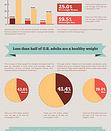Obesity is defined as an abnormal accumulation of body fat, usually 20% or more over an individual's ideal body weight (Ford-Martin, 2003). Not long ago, obesity was revered as a sign of wealth. But in the 1900s, the ideal body type began to get thinner. The impact was felt primarily on woman and somehow their success in life became linked to how thin they were. Science is now grasping the fact that biology plays a major role in body weight. Weight control is a huge medical problem in the U.S. (Powell, 2001). About half of the people in U.S. are overweight and one third are clinically obese (Powell, 2001). Obesity is the second leading cause of preventable death in the U.S. (Graham, 2002). Americans fork over more than $30 billion a year on weight loss endeavors (Graham, 2002). But Americans aren't alone when it comes to weight problems. According to new statistics, 1.1
billion people worldwide have a body mass index higher than 25, which classifies them as obese or overweight (Powell, 2001). Figure 1 shows U.S. has the highest percentage of overweight adults in the 7 most obese countries of the world. To thoroughly understand how the body controls body weight, one must grasp the "set point" theory of weight control. Many factors contribute to obesity. According to scientists, genetics is the major cause of obesity. Due to extensive researching, many diseases and illnesses are now acknowledged as symptoms of obesity. In addition, different types of treatments for obesity are now available for different types of obese people.
One of the biggest breakthroughs in obesity studies was the discovery of a hormone called leptin. Leptin was originally identified late in 1994 by Rockefeller University researchers led by Jeffrey Friedman (Kluger, 2001). It is encoded by the obese (OB) gene...



Very well presented
Many people are not aware of the "fat gene" and wonder why their weight yo-yos. Thank you for bringing that to light.
0 out of 0 people found this comment useful.